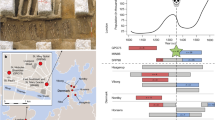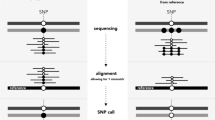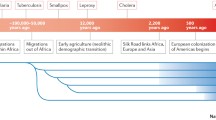Abstract
Pathogens have played a substantial role in human evolution, with past infections shaping genetic variation at loci influencing immune function. We selected 168 genes known to be involved in the immune response, genotyped common single nucleotide polymorphisms across each gene in three population samples (CEPH Europeans from Utah, Han Chinese from Guangxi, and Yoruba Nigerians from Southwest Nigeria) and searched for evidence of selection based on four tests for non-neutral evolution: minor allele frequency (MAF), derived allele frequency (DAF), Fst versus heterozygosity and extended haplotype homozygosity (EHH). Six of the 168 genes show some evidence for non-neutral evolution in this initial screen, with two showing similar signals in independent data from the International HapMap Project. These analyses identify two loci involved in immune function that are candidates for having been subject to evolutionary selection, and highlight a number of analytical challenges in searching for selection in genome-wide polymorphism data.



Similar content being viewed by others
References
Akey JM, Zhang G, Zhang K, Jin L, Shriver MD (2002) Interrogating a high-density SNP map for signatures of natural selection. Genome Res 12:1805–1814
Ali S, Niang MA, N’Doye I, Critchlow CW, Hawes SE, Hill AV, Kiviat NB (2000) Secretor polymorphism and human immunodeficiency virus infection in Senegalese women. J Infect Dis 181:737–739
Barrett JC, Fry B, Maller J, Daly MJ (2005) Haploview: analysis and visualization of LD and haplotype maps. Bioinformatics 21(2):263–265
Clark AG, Glanowski S, Nielsen R, Thomas PD, Kejariwal A, Todd MA, Tanenbaum DM, Civello D, Lu F, Murphy B, Ferriera S, Wang G, Zheng X, White TJ, Sninsky JJ, Adams MD, Cargill M (2003) Inferring nonneutral evolution from human-chimp-mouse orthologous gene trios. Science 302:1960–1963
Cohen AW, Hnasko R, Schubert W, Lisanti MP (2004) Role of caveolae and caveolins in health and disease. Physiol Rev 84:1341–1379
Cooper R, Rotimi C, Ataman S, McGee D, Osotimehin B, Kadiri S, Muna W, Kingue S, Fraser H, Forrester T, Bennett F, Wilks R (1997) The prevalence of hypertension in seven populations of west African origin. Am J Public Health 87:160–168
Cooper RS, Luke A, Zhu X, Kan D, Adeyemo A, Rotimi C, Bouzekri N, Ward R (2002) Genome scan among Nigerians linking blood pressure to chromosomes 2, 3, and 19. Hypertension 40:629–633
Demoulin JB, Renauld JC (1998) Interleukin 9 and its receptor: an overview of structure and function. Int Rev Immunol 16:345–364
Fan JB, Yeakley JM, Bibikova M, Chudin E, Wickham E, Chen J, Doucet D, Rigault P, Zhang B, Shen R, McBride C, Li HR, Fu XD, Oliphant A, Barker DL,Chee MS (2004) A versatile assay for high-throughput gene expression profiling on universal array matrices. Genome Res 14(5):878–885
Fay JC, Wu CI (2000) Hitchhiking under positive Darwinian selection. Genetics 155:1405–1413
Hamajima N (2003) Persistent helicobacter pylori infection and genetic polymorphisms of the host. Nagoya J Med Sci 66:103–117
Hamblin MT, Thompson EE, Di Rienzo A (2002) Complex signatures of natural selection at the Duffy blood group locus. Am J Hum Genet 70:369–383
Hinds DA, Stuve LL, Nilsen GB, Halperin E, Eskin E, Ballinger DG, Frazer KA, Cox DR (2005) Whole-genome patterns of common DNA variation in three human populations. Science 307:1072–1079
Hudson RR (1990) Gene genealogies and the coalescent process. Oxford surveys in evolutionary biology, vol 7. pp1–44
Kimura M, (1983) The neutral theory of molecular evolution. Cambridge University Press, Cambridge New York
Koda Y, Ishida T, Tachida H, Wang B, Pang H, Soejima M, Soemantri A, Kimura H (2003) DNA sequence variation of the human ABO-secretor locus (FUT2) in New Guinean populations: possible early human migration from Africa. Hum Genet 113:534–541
Koda Y, Soejima M, Liu Y, Kimura H (1996) Molecular basis for secretor type alpha(1,2)-fucosyltransferase gene deficiency in a Japanese population: a fusion gene generated by unequal crossover responsible for the enzyme deficiency. Am J Hum Genet 59:343–350
Lewontin RC (1995) The detection of linkage disequilibrium in molecular sequence data. Genetics 140:377–388
Liu YH, Koda Y, Soejima M, Pang H, Wang BJ, Kim DS, Oh HB, Kimura H (1999) The fusion gene at the ABO-secretor locus (FUT2): absence in Chinese populations. J Hum Genet 44:181–184
Nei M, (1987) Molecular evolutionary genetics (Eqn 8.4). Columbia University Press, New York
Nei M, Chesser RK (1983) Estimation of fixation indices and gene diversities. Ann Hum Genet 47(Pt 3):253–259
Nielsen R, Bustamante C, Clark AG, Glanowski S, Sackton TB, Hubisz MJ, Fledel-Alon A, Tanenbaum DM, Civello D, White TJ, J JS, Adams MD, Cargill M (2005) A scan for positively selected genes in the genomes of humans and chimpanzees. PLoS Biol 3:e170
O’Brien SJ, Nelson GW (2004) Human genes that limit AIDS. Nat Genet 36:565–574
Raza MW, Blackwell CC, Molyneaux P, James VS, Ogilvie MM, Inglis JM, Weir DM (1991) Association between secretor status and respiratory viral illness. BMJ 303:815–818
Reich DE, Gabriel SB, Altshuler D (2003) Quality and completeness of SNP databases. Nat Genet 33:457–458
Sabeti PC, Reich DE, Higgins JM, Levine HZ, Richter DJ, Schaffner SF, Gabriel SB, Platko JV, Patterson NJ, McDonald GJ, Ackerman HC, Campbell SJ, Altshuler D, Cooper R, Kwiatkowski D, Ward R, Lander ES (2002) Detecting recent positive selection in the human genome from haplotype structure. Nature 419:832–837
Sachidanandam R, Weissman D, Schmidt SC, Kakol JM, Stein LD, Marth G, Sherry S, Mullikin JC, Mortimore BJ, Willey DL, Hunt SE, Cole CG, Coggill PC, Rice CM, Ning Z, Rogers J, Bentley DR, Kwok PY, Mardis ER, Yeh RT, Schultz B, Cook L, Davenport R, Dante M, Fulton L, Hillier L, Waterston RH, McPherson JD, Gilman B, Schaffner S, Van Etten WJ, Reich D, Higgins J, Daly MJ, Blumenstiel B, Baldwin J, Stange-Thomann N, Zody MC, Linton L, Lander ES, Altshuler D (2001) A map of human genome sequence variation containing 1.42 million single nucleotide polymorphisms. Nature 409:928–933
Schaeffer AJ, Rajan N, Cao Q, Anderson BE, Pruden DL, Sensibar J, Duncan JL (2001) Host pathogenesis in urinary tract infections. Int J Antimicrob Agents 17:245–251
Schaffner SF, Foo C, Gabriel S, Reich D, Daly MJ, Altshuler D (2005) Calibrating a coalescent simulation. Genome Res 15(11):1576–1583
Schultz MJ, Wijnholds J, Peppelenbosch MP, Vervoordeldonk MJ, Speelman P, van Deventer SJ, Borst P, van der Poll T (2001) Mice lacking the multidrug resistance protein 1 are resistant to Streptococcus pneumoniae-induced pneumonia. J Immunol 166:4059–4064
Taylor MF, Shen Y, Kreitman ME (1995) A population genetic test of selection at the molecular level. Science 270:1497–1499
Tishkoff SA, Dietzsch E, Speed W, Pakstis AJ, Kidd JR, Cheung K, Bonne-Tamir B, Santachiara-Benerecetti AS, Moral P, Krings M (1996) Global patterns of linkage disequilibrium at the CD4 locus and modern human origins. Science 271:1380–1387
Walsh EC, Mather KA, Schaffner SF, Farwell L, Daly MJ, Patterson N, Cullen M, Carrington M, Bugawan TL, Erlich H, Campbell J, Barrett J, Miller K, Thomson G, Lander ES, Rioux JD (2003) An integrated haplotype map of the human major histocompatibility complex. Am J Hum Genet 73:580–590
Wijnholds J (2002) Drug resistance caused by multidrug resistance-associated proteins. Novartis Found Symp 243:69–79; discussion 80–82, 180–185
Acknowledgments
E.C.W was supported by a Cancer Research Institute fellowship. PCS is funded by the Damon Runyon Cancer Research Foundation and by a L’Oreal Women in Science Award. H.B.H. is an NCI Cancer Research Training Award (CRTA) Postdoctoral Fellow. This work was funded through a special grant from the National Institutes of Health National Institute of Allergy and Infectious Disease. This publication has been funded in whole or in part with Federal funds from the National Cancer Institute, National Institutes of Health, under contract no. NO1-CO-12400. The content of this publication does not necessarily reflect the views or policies of the Department of Health and Human Services, nor does mention of trade names, commercial products, or organizations imply endorsement by the US Government. This research was support in part by the Intramural Research Program of the NIH, National Cancer Institute, Center for Cancer Research.
Author information
Authors and Affiliations
Corresponding author
Additional information
Emily C. Walsh, Pardis Sabeti, Holli B. Hutcheson, and Ben Fry have contributed equally to this work and Stephen O’Brien and David Altshuler have jointly supervised this project
Electronic supplementary material
Rights and permissions
About this article
Cite this article
Walsh, E.C., Sabeti, P., Hutcheson, H.B. et al. Searching for signals of evolutionary selection in 168 genes related to immune function. Hum Genet 119, 92–102 (2006). https://doi.org/10.1007/s00439-005-0090-0
Received:
Accepted:
Published:
Issue Date:
DOI: https://doi.org/10.1007/s00439-005-0090-0




